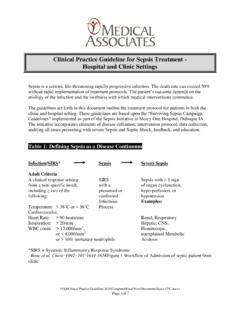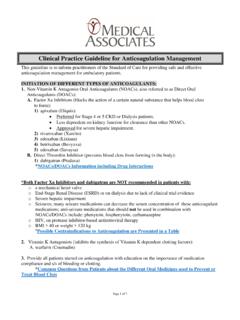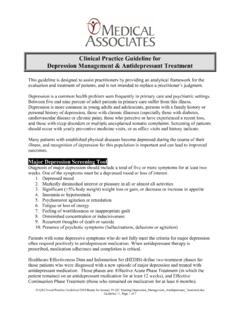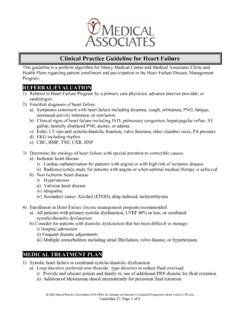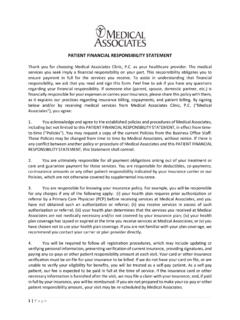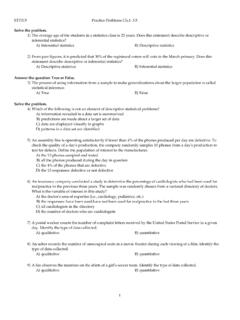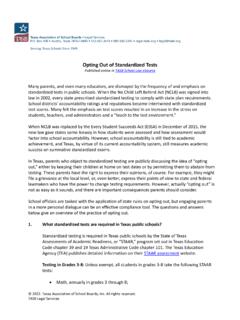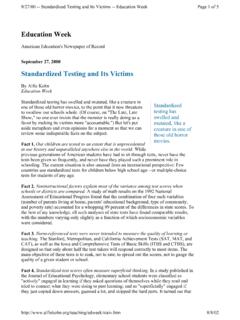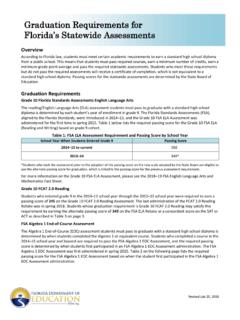Transcription of Clinical Practice Guidelines for Diabetes Management
1 Clinical Practice Guidelines for Diabetes Management Diabetes is a disease in which blood glucose levels are above normal. Over the years, high blood glucose damages nerves and blood vessels, which can lead to complications such as heart disease, stroke, kidney disease, blindness, nerve damage, gum infections, and peripheral vascular disease. Impaired Fasting Glucose (IFG), Impaired Glucose Tolerance (IGT), and an A1C of are included in a category of increased risk for future Diabetes (also known as pre- Diabetes ). This is defined as blood glucose or A1C levels higher than normal but not high enough to be characterized as Diabetes . People with IFG, IGT, and an increase A1C are at risk for developing type 2 Diabetes and have an increased risk of heart disease and stroke.
2 With modest weight loss and moderate physical activity, people with pre- Diabetes can delay or prevent type 2 Diabetes . A1C testing is an appropriate test for diagnosing Diabetes when A1C is greater than or equal to Diagnosis should be confirmed by a repeat A1C test unless Clinical symptoms and glucose levels over 200 mg/dL are present. A1C testing may not be reliable due to patient factors which preclude its interpretation ( any anemia, hemoglobinopathy or abnormal erythrocyte turnover). In this case, previously recommended diagnostic measures should be used (fasting plasma glucose and 2 hour oral glucose tolerance test). American Diabetes Association Criteria for testing for IFG and Diabetes in asymptomatic adults 1. All adults with a BMI > 25 and have additional risk factors Physical inactivity First-degree relative with Diabetes High risk ethnic population: African American, Latino, Native American, Pacific Islander.
3 (Asian Americans 23). Women who were diagnosed with gestational Diabetes ;. Hypertension (>140/90 or on therapy for hypertension). HDL <35 and/or triglycerides > 250. Women with polycystic ovarian syndrome IGT or IFG on previous testing or A1C Other Clinical conditions related to insulin resistance (severe obesity, acanthosis nigricans). History of CVD. 2. In the absence of the above criteria, testing for Diabetes should begin at age 45. 3. If the results are normal, testing should be repeated in at least a 3 year interval, with consideration to more frequent testing depending on initial results and risk status. H:\QI\ Clinical Practice Guidelines \2018\Ready for January 18 QIC Meeting\ Diabetes CPG. Guideline 12, Page 1 of 5. Diagnosing Using Fasting Plasma Glucose Levels Plasma Glucose Diagnosis Result (mg/dL).
4 99 and below Normal 100 to 125 Impaired Fasting Glucose - Diagnosis code 126 and above Diabetes - Diagnosis code or - (See Addendum for further classification codes). Diagnosing Using A1C. Plasma Glucose Diagnosis Result (mg/dL). < Normal Increased Risk for Diabetes (pre- Diabetes ) - Diagnosis code and Diabetes - Diagnosis code or (See Addendum for further classification codes). Diagnosing Using Oral Glucose Tolerance Test Oral Glucose Tolerance Test (OGTT) is defined based on the glucose response two hours after a 75 gram glucose load. Plasma Glucose Diagnosis Result (mg/dL). Under 140 Normal glucose tolerance 140 to 199 Impaired Glucose Tolerance-Diagnosis code 200 and above Diabetes - Diagnosis code or (See Addendum for further classification codes). Diagnosis code (Other Abnormal Glucose), abnormal non-fasting glucose, would be used when the patient had an elevated glucose and was not fasting or when the practitioner is not certain which pre- Diabetes code is appropriate.
5 Criteria for Diabetes Mellitus 1) Symptoms of Diabetes and a casual plasma glucose greater than or equal to 200 mg/dl. Casual is defined as any time of day without regard to the time since the last meal. The classic symptoms of Diabetes include polyuria, polydipsia, and unexplained weight loss. 2) Fasting plasma glucose greater than or equal to 126 mg/dl. Fasting is defined as no caloric intake for at least eight hours. To fit criteria for formal diagnosis of Diabetes , the elevated H:\QI\ Clinical Practice Guidelines \2018\Ready for January 18 QIC Meeting\ Diabetes CPG. Guideline 12, Page 2 of 5. glucose must be confirmed by repeating the fasting glucose test a second time on a different day. 3.) Two-hour plasma glucose greater than or equal to 200 mg/dl during an oral glucose tolerance test.
6 The test should be performed as described by the World Health Organization (WHO), using a glucose load containing the equivalent of 75g anhydrous glucose dissolved in water. 4.) A1c greater than or equal to The test should be performed in a laboratory using a method that is National Glycohemoglobin Standardization Program (NGSP) certified and standardized to the Diabetes Control and Complications Trial (DCCT) reference assay. Diagnosis should be confirmed by a repeat A1C test unless Clinical symptoms and glucose levels over 200 mg/dL are present. In the absence of unequivocal hyperglycemia with acute metabolic decompensation, these criteria should be confirmed by repeat testing on a different day. The oral glucose tolerance test is not recommended for routine Clinical use.
7 Different criteria are used to diagnose gestational Diabetes in pregnant women. Recommendations for Management of Diabetes 1) Complete history and physical examination upon initial diagnosis (including a fasting plasma glucose, HgbA1C, lipid profile, serum creatinine, urinalysis for glucose, ketones, protein and evidence of infection, determination for microalbuminuria, urine culture if evidence of infection and thyroid function tests when indicated, neurological examination, foot and skin examinations). 2) Screen for psychosocial problems such as depression and Diabetes related distress, anxiety, eating disorders, and cognitive impairment when self- Management is poor. 3) Hemoglobin A1C level: a. Every three months if treatment changes or patient is not meeting goal A1C.
8 B. Twice per year if stable and meeting goals c. In general, recommend goal Hemoglobin A1C level under This A1C goal does not apply to all patients Goal A1C must be determined for each specific patient by their physician based on a balance of the benefits of glucose control versus the risk of a severe low glucose event. Less stringent AlC goals may be appropriate for patients with a history of severe hypoglycemia, patients with limited life expectancies, children, individuals with comorbid conditions, and those with longstanding Diabetes and minimal or stable microvascular complications. 4) Dilated retinal eye exam yearly by an Ophthalmologist or Optometrist 5) Annual foot exam for all patients with Diabetes . All patients with insensate feet, foot deformities, and/or history of foot ulcers should have foot exam at every visit.
9 Include general foot self-care education. 6) Fasting cholesterol panel is reasonable at diagnosis, at the initial medical evaluation (and/or age 40), and every 1-2 years thereafter. 7) Microalbumin measurement once yearly spot urine test for microalbumin to creatinine ratio in mg/gm creatinine. Annual serum creatinine level, regardless of urine albumin excretion. 8) Blood pressure at every Diabetes visit: recommend BP < 140/90. 9) Lower blood pressure targets, such as <130/80, may be appropriate for certain individuals such as younger patients, if it can be achieved without undue treatment burden H:\QI\ Clinical Practice Guidelines \2018\Ready for January 18 QIC Meeting\ Diabetes CPG. Guideline 12, Page 3 of 5. 10) Patients with blood pressure >120/80 should be advised on lifestyle changes to reduce blood pressure.
10 Provide patient education regarding regular meal planning, nutritional Guidelines , need for regular exercise, and home glucose monitoring 11) Provide patient education regarding weight loss and smoking cessation, if indicated, at each visit 12) Check weight as a vital sign at every Diabetes visit 13) Recommend yearly dental exam/referral 14) Recommend annual influenza vaccine 15) Recommend pneumoccocal vaccine at diagnosis and revaccinate per CDC Guidelines 16) Recommend hepatitis B vaccine to unvaccinated adults ages 19-59, consider ages 60+. American Diabetes Association Recommended Treatment 1) Consider aspirin therapy as a primary prevention strategy in those with Type I or Type 2. Diabetes at increased cardiovascular risk (10-year risk >10%). This includes most men >50 and women >60 who have at least one additional major risk factor (family history of CVD, hypertension, smoking, dyslipidemia, or albuminuria).
